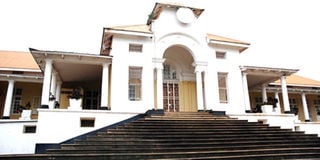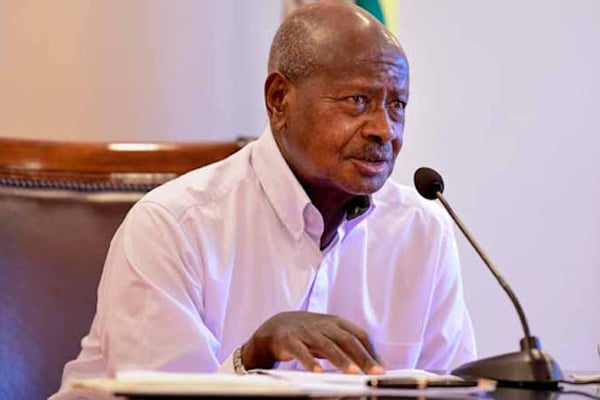Prime
Tracing the origin of the Uganda Legislative Council

The front view of the first Ugandan Parliament and office to governor’s secretary. Photo by Martin Ssebuyira
Information about the beginnings of the Legislative Council in Uganda is hard to come by. Most of it can only be found on the Uganda Parliament website. According to the website, the first elements of a legislative organ can be traced as far back as the turn of the century in 1888 when the then Imperial British East African Company started some kind of administration in Uganda. Although this company was a private one, its charter authorised it, inter alia, 'To undertake the duties of general administration, imposition and collection of taxes and administration of justice in areas under its control'.
There is no doubt that in doing this, the company acted as the agent and for the benefit of the British Crown. Hence the first traces of legislation were manifested in the various pieces of regulations passed by the company.
Mr Simon Peter Kezmibira, 75, a former communications boss of Entebbe Airport and senior resident in Entebbe, says the governor used to sleep in the government house nowadays referred to as State House.
“No Ugandan would be allowed to access the premises with the exception of the governor’s two artisans who used to repair his vehicles and his driver only identified as Mapesa,” Mr Kezimbira recalls. He adds that Legco used to sit in State House and sometimes in the secretary to the governor’s office before being transferred to Kampala.
Mr Alex Okello, a national archivist of National Archives, however says the governor’s office was located at the then public service office that currently houses National Agricultural Research Organisation (NARO) head offices.
A visit to the place shows that the structure still has old images of a legislative house such as paintings of the Uganda flag in front of the administration offices, court of arms and other distinctive features.
Historical events
Because blacks were stopped from accessing the place and hardly know much history about the formal proceedings that unfolded in this parliament, history from the Parliament website shows that the year 1902 marked an important landmark.
In that year, an Order-in-Council was passed and under this ordinance, new provisions for the administration of Uganda were made. It also designated an official responsible for administration, the commissioner.
Article 12 of the ordinance also empowered the commissioner to make ordinances for the administration of justice, rising of revenues and generally for peace, order and good government of all persons in Uganda.
In effect, the 1902 ordinance established a system of legislation through the declaration of personal decrees by the representatives of the British Crown, namely the Commissioner. This system continued up to 1920.
Mr Charles Bukenya, 80 who was a cleaner at the then Parliament, recalls that NARO offices were the governor’s secretary office, but the governor sat in State House.
“We used to call it ‘Sectari’ because many people couldn’t pronounce secretary, but it was out of bounds for most black people,” he says. He adds that many parliamentary meetings were held in this place before the parliament building was officially commissioned on October 9, 1962.
Mr Abner- Ner Ssenditta Kiryowa, 80 recalls having come to Entebbe in 1952 to take on his role as a draftsman in the drawing office at the Geological survey department Ministry of water and Mineral resources. He backs Bukenya’s claims that the secretary to the governor’s office hosted the first Legco.
“We all know that the first Parliament was in the secretary to the governor’s office though it was restricted to only blacks,” he says
Administration
Although Mr Bukenya, Mr Kezimbira and the people interviewed above don’t recall people who first served in the legislative house, Uganda Parliament history shows that an order in council was publicised in 1920. It made provision for yet another important landmark in the legislative development of Uganda. A legislative body was created and it designated its own membership.
The body was to be called the Legislative Council, otherwise known as the Legco. At the time all its seven members were Europeans. The governor, Sir Robert Coryndon was the President of the Council. The other official members were the chief secretary, Mr E.B. Jarvis, the Acting Attorney General, Mr A.B. Howes, the treasurer, Mr A.E. Boory and the Principal Medical Officer, Dr C.A. Wiggins.
There were also two other officials. Mr E.H. Levis and Mr W.S. Garnhem (who was deputising for Dr. H.H. Hunter). The Council first met on March 23, 1921, in the High Court Chambers at Entebbe apparently housing the National Meteorological Training School near Entebbe Magistrate’s court in Entebbe town.
Later, meetings were held in the Library of the Chief Secretary’s Office. Henceforth personal decrees ceased and laws were made by the Governor, assisted by the Council, which consisted of officials.
From then onwards, there began to occur changes in the composition of this body. On May 26, 1926 the first Asian, Mr Chrunabai Jekabhai Amin, was sworn in as a member of the Council. It was indeed a step in the direction of still closer co-operation in the furtherance of the interests of the Protectorate as a whole.
These developments continued such that by 1945, the council was composed of Europeans, the Asians and Africans. On October 23, 1945 the Governor, Sir John Hall, announced that the Secretary of State for the Colonies had approved a scheme for the nomination of three African Members of the Legislative council, representing Buganda; Eastern and Western Provinces.
On December 4, 1945, the first Africans to join the Legco were sworn in. They included Michael Earnest Kawalya Kaggwa, Petero Nyangabyaki and Yekonia Zirabamuzaale. They were the Katikkiro of Buganda, Katikkiro of Bunyoro and the Secretary General of Busoga respectively.
Elections
However, elections to the council were still by indirect methods. In 1946, an additional European and Asian Representative Member was appointed while the first unofficial Member of the Executive Council was appointed Mr H.K. Jaffer, the Senior Member of the unofficial side of the Legco.
Three years later, the Northern Province was reconstituted and allowed its own representative in the house. This meant that there were now four Africans; three Europeans and three Asians on the unofficial seats. By 1955, the membership of the council had increased to 60 and its meetings used to be held in Kampala City Council chambers.
In the late 1950s, pressure continued to mount for self-government in the protectorate as a whole. This led to a series of constitutional changes, notable among these, were the changes in the electoral law, which brought about the introduction of a common role provided for direct elections and increased once again the membership of the legislature.
All these ended in the holding of the first ever direct elections for the greater part of the protectorate in 1961, under the new Franchise law. This election returned an African majority into the Legislative council. The Democratic Party (DP) led by Ben Kiwanuka, formed the majority party while the Uganda People’s Congress (UPC), led by Apollo Milton Obote, formed the opposition.
Official meetings
This new Council met for the first time on April 17, with Sir John Bowes Griffin as the first Speaker. Earlier, on September 15, 1960, the Governor, Sir Fredrick Crawford had issued a proclamation to the effect that from the September 19, 1960, all Legco meetings would be held in the present Parliamentary Buildings.
In 1962, General Elections were held. The Uganda People’s Congress (UPC) led by A.M. Obote won with 37 seats gainst 24 for the Democratic Party (DP) excluding Buganda. Buganda region had opted for indirect election, hence its Lukiiko nominated 21 representatives to the National Assembly.
The Buganda representatives struck an alliance with the UPC known as UPC/KY Alliance, which gave it the necessary strength to form a coalition government with A.M. Obote as the Prime Minister and DP led by Ben Kiwanuka in opposition.




